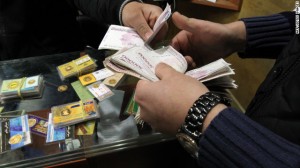 The international banking sanctions that have crippled�Iran�s economy�did not discourage Parviz Aghili from opening what is in effect the country�s only privately owned bank, the Middle East bank, this year.
The international banking sanctions that have crippled�Iran�s economy�did not discourage Parviz Aghili from opening what is in effect the country�s only privately owned bank, the Middle East bank, this year.Its focus on domestic corporate clients and wealthy individuals within Iran�s private sector means it should be able to thrive, says Mr Aghili. Since it opened its doors in January, the Middle East bank � the smallest Iranian bank with only three branches so far � has attracted 1.4tn rials ($114m)�in deposits and granted 3tn rials in loans.
But the greater challenge for the western-educated veteran banker will be avoiding the fate of Iran�s other private banks, which, beset by interference from state authorities and cronies, are private in name only.
�We have no interest in attracting state-owned or quasi-state-owned companies as shareholders or as clients,� Mr Aghili, the bank�s managing director, said. �There are enough privately owned companies in the country, which will help our business to grow.�
It is more than a decade since�Iran�encouraged the creation of private banks and later privatised state banks. But while 19 of Iran�s 27 banks are officially considered to be privately owned, often these banks are at least part owned by companies affiliated to those with political backing or state-run organisations, such as the elite Revolutionary Guards. Few are genuinely independent or private.
This is part of an unspoken government policy of not letting Iran�s private sector � which constitutes about 20 per cent of the economy � grow too big in case its entrepreneurs relay their economic power into political influence.
Mr Aghili has no political ambitions but is keen to remain independent from government influence. Under the bank�s rules, no shareholder can hold more than a 5 per cent stake, a rule designed to deter companies affiliated to the regime from buying the bank�s shares.
His caution is rooted in experience. He founded Karafarin Bank, one of the country�s biggest banks and its first privately owned bank. �A couple of nouveau riche directors with no banking knowledge were intervening in the [Karafarin] bank�s decision-making process and at the same time a few quasi-state-owned companies had taken a large stake in the bank�s capital�, he said.
Mr Aghili quit his job in protest and had to wait for more than two years to open the Middle East Bank since his application to the Central Bank.
Iran remains a tough banking environment. The banking sector � already suffering from undercapitalisation and poor regulation � has been squeezed not only by�international banking sanctions, that stop international banks from dealing with Iranian banks, but also by the populist policies of president Mahmoud Ahmadi-Nejad.
Mr Ahmadi-Nejad�s government has kept interest rates up to 20 per cent below the inflation rate � now officially at 32.2 per cent but believed to be much higher � and urged banks to grant cheap loans to the needy. This has not only boosted inflation but also the number of non-performing loans, which now account for more than 20 per cent of all loans.
For now, unlike other Iranian banks, the Middle East bank plans to remain small. It has hired a �young strong team� and hopes to train a generation of senior managers with private sector experience, unusual in Iran.
The bank�s small size could also protect it from government interest. �I am under no pressure to let in the companies which are affiliated to the government,� he said, �maybe because we are too small at present or maybe because they now have enough banks to rely on.�
It has also cast its eye beyond Iran. The bank plans to open representative offices in countries such as India and Oman. �We need to be prepared for the day when the sanctions are lifted and Iran has to deal with the world differently,� he said.
By The Financial Times
The Iran Project is not responsible for the content of quoted articles.










